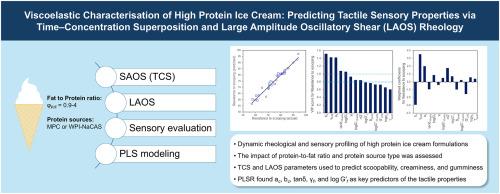高蛋白冰淇淋的粘弹性特性:通过时间-浓度叠加和大振幅振荡剪切(老挝)流变学预测触觉感官特性
IF 11
1区 农林科学
Q1 CHEMISTRY, APPLIED
引用次数: 0
摘要
在目前的工作中,我们报告了时间浓度叠加原理(TCS)和非线性动态流变学(LAOS)的探索,作为预测冰淇淋在服务温度(- 14°C)下的触觉感觉模式的有用工具。在蛋白与脂肪比(φP/F = 0.9至4)和蛋白质来源(乳蛋白浓缩物(MPC) vs乳清分离蛋白-酪蛋白酸钠(WPICAS) 1:1混合物)不同的高蛋白配方中,评估了冰淇淋的三个常见触觉感官特性,即抗舀性(可舀性)、奶油性和粘性。复黏度-角频率数据符合TCS原理,计算得到的位移因子ac∝φP/F1.16和φP/F2.23, bc∝φP/F−1.27和φP/F−1.75,MPC和WPICAS强化体系的位移因子较好地反映了冰淇淋的成分分布。老挝评价表明,蛋白类型和φP/F对冰淇淋的剪切变形有明显的影响。强化MPC和降低φP/F提高了冰淇淋的剪切流动能力。在所有情况下,剪切硬化和增厚行为的开始是在剪切应力低于流点时观察到的,这表明凝胶状或胶体玻璃状结构。通过偏最小二乘回归分析,确定了TCS参数(ac和bc)、阻尼因子(tanδ)、流点剪切应变(γf)和弹性模量(log Gf’)是预测大变形(勺状)时的可湿性、奶油性和粘性等触觉感觉形态的最重要参数。本文章由计算机程序翻译,如有差异,请以英文原文为准。

Viscoelastic characterisation of high protein ice cream: Predicting tactile sensory properties via time–concentration superposition and large amplitude oscillatory shear (LAOS) rheology
In the present work we report on the exploration of time concentration superposition principle (TCS) and non-linear dynamic rheology (LAOS) as useful instrumental tools for predicting tactile sensory modalities of ice cream at serving temperature (−14 °C). Three common tactile sensory properties of ice cream i.e., resistance to scooping (scoopability), creaminess and gumminess were assessed in high protein formulations differing in their protein to fat ratio (φP/F = 0.9 to 4) and protein source (milk protein concentrate (MPC) vs whey protein isolate-sodium caseinate (WPICAS) 1:1 blend). The complex viscosity – angular frequency data obeyed the TCS principle with the calculated shift factors reflecting effectively the compositional profile of ice creams i.e., ac ∝ φP/F1.16 and φP/F2.23, bc ∝ φP/F−1.27 and φP/F−1.75 for MPC and WPICAS fortified systems. LAOS assessment revealed a clear impact of protein type and φP/F on the shearing deformation of ice creams. MPC fortification and decrease in the φP/F enhanced the shear flowing ability of the ice creams. In all cases, the onset of shear stiffening and thickening behaviour was observed at shear stresses below the flow point, which indicates gel-like or colloid glass-like structures. According to partial least squares regression analysis, the TCS parameters (ac and bc), damping factor (tanδ) and the shear strain (γf) and elastic modulus (log ) at flow point were determined as the most important parameters predicting tactile sensory modalities on large deformation (spooning) such as scoopability, creaminess and gumminess.
求助全文
通过发布文献求助,成功后即可免费获取论文全文。
去求助
来源期刊

Food Hydrocolloids
工程技术-食品科技
CiteScore
19.90
自引率
14.00%
发文量
871
审稿时长
37 days
期刊介绍:
Food Hydrocolloids publishes original and innovative research focused on the characterization, functional properties, and applications of hydrocolloid materials used in food products. These hydrocolloids, defined as polysaccharides and proteins of commercial importance, are added to control aspects such as texture, stability, rheology, and sensory properties. The research's primary emphasis should be on the hydrocolloids themselves, with thorough descriptions of their source, nature, and physicochemical characteristics. Manuscripts are expected to clearly outline specific aims and objectives, include a fundamental discussion of research findings at the molecular level, and address the significance of the results. Studies on hydrocolloids in complex formulations should concentrate on their overall properties and mechanisms of action, while simple formulation development studies may not be considered for publication.
The main areas of interest are:
-Chemical and physicochemical characterisation
Thermal properties including glass transitions and conformational changes-
Rheological properties including viscosity, viscoelastic properties and gelation behaviour-
The influence on organoleptic properties-
Interfacial properties including stabilisation of dispersions, emulsions and foams-
Film forming properties with application to edible films and active packaging-
Encapsulation and controlled release of active compounds-
The influence on health including their role as dietary fibre-
Manipulation of hydrocolloid structure and functionality through chemical, biochemical and physical processes-
New hydrocolloids and hydrocolloid sources of commercial potential.
The Journal also publishes Review articles that provide an overview of the latest developments in topics of specific interest to researchers in this field of activity.
 求助内容:
求助内容: 应助结果提醒方式:
应助结果提醒方式:


